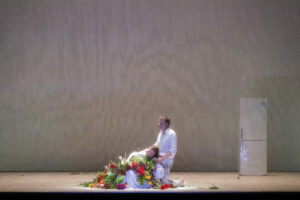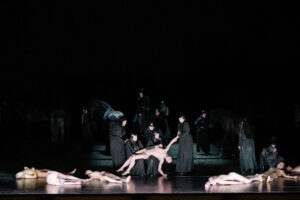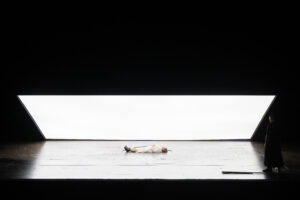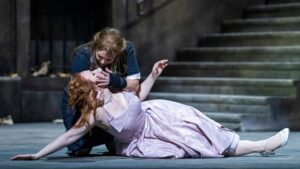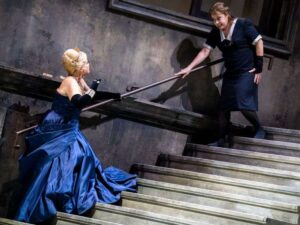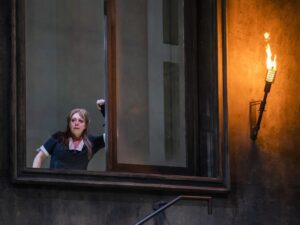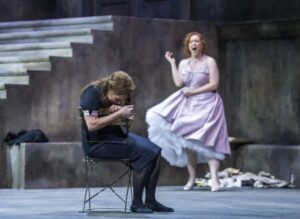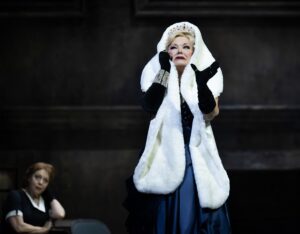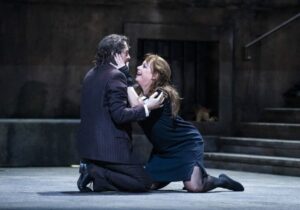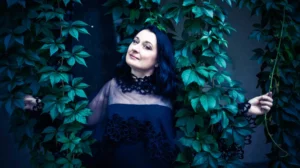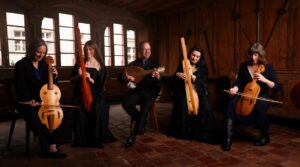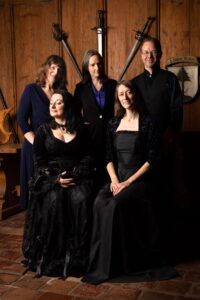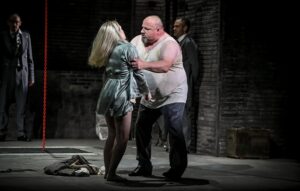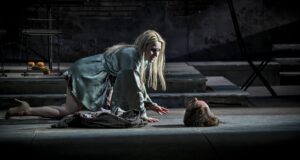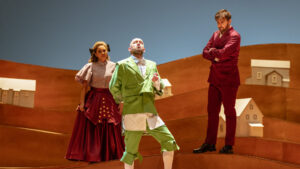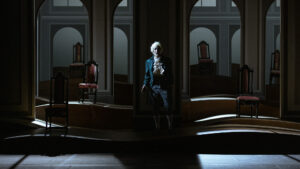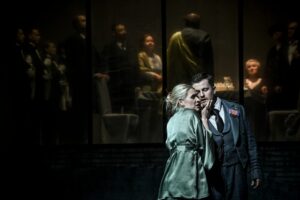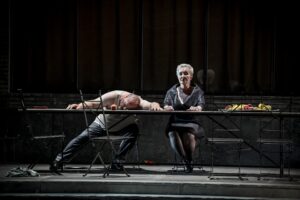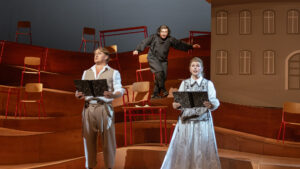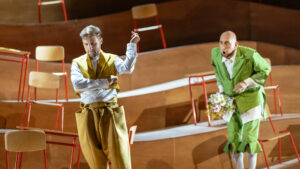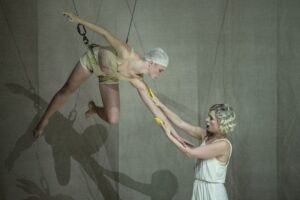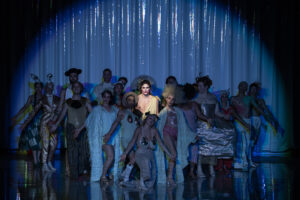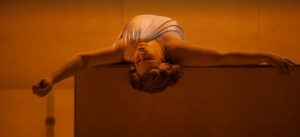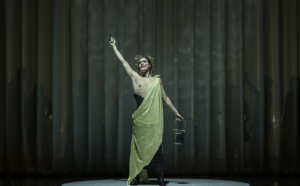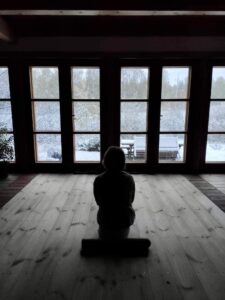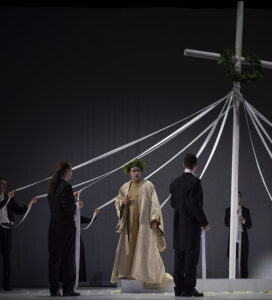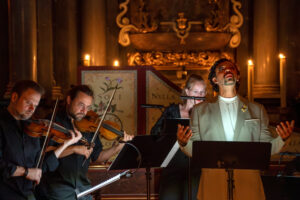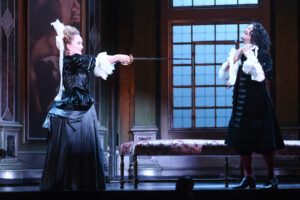Jak krew z mlekiem
Przeszło dziesięć lat temu, kiedy do Polski dotarł spektakl Romea Castellucciego The Four Seasons Restaurant, Jacek Kopciński zżymał się na komentarz zamieszczony w książce programowej Malta Festival: przykład żenującego pustosłowia, „tolerowanej dziś mowy-trawy, która bujnie porasta programy teatralne, foldery i ulotki, pleni się w telewizji i oczywiście w Internecie (…), skąd następnie trafia do recenzji, a stamtąd do prac magisterskich i rozpraw doktorskich, cytowanych następnie w programach – i koło się zamyka”. Podobnie jak Kopciński, nie mam zwyczaju czytać zapowiedzi przed spektaklem, i podobnie jak on, często przecieram oczy ze zdumienia, kiedy zapoznam się z ich treścią po obejrzeniu przedstawienia. Mierząc się jednak z twórczością Castellucciego, co do którego znów zgadzam się z Kopcińskim, że jest tyleż znanym, co nierozumianym reżyserem przeczuć eschatologicznych, sama boję się wpaść w pułapkę pustosłowia. Teatr włoskiego artysty – nierzeczywisty, wywiedziony z logiki i estetyki snu – operuje taką liczbą symboli i odniesień kulturowych, że recenzja każdej jego inscenizacji może się rozrosnąć do rozmiarów doktoratu. I trafić kulą w płot, bo spektakle Castellucciego działają jak bomba z opóźnionym zapłonem. Poszczególne ich elementy wracają do widza jak odzyskane marzenia senne. Tworzą wspomnienia fałszywe, dzięki którym odbiorca doznaje czegoś w rodzaju objawienia – następstwo kilku onirycznych scen potrafi bowiem wygenerować w jego mózgu obraz, którego nie było, a który okaże się kluczem do interpretacji całości.
Twardo stoję na stanowisku, że teatr nie jest dziurką od klucza i nie służy do podglądania rzeczywistości: dlatego tak cenię spektakle Castellucciego i w ich opisie staram się oprzeć pokusie dzielenia włosa na czworo i pedantycznego wyłapywania nawarstwiających się znaków. Na Walkirię – drugą część tetralogii Wagnera w jego inscenizacji – wybrałam się do La Monnaie przede wszystkim ze względu na osobisty sentyment do tego utworu: doskonale skonstruowanego pod względem dramaturgicznym, a co za tym idzie, umożliwiającego odbiorcy głęboki wgląd w motywacje i uczucia bohaterów. Zaintrygowała mnie też deklaracja reżysera, że każde z ogniw brukselskiego Pierścienia potraktuje nie tylko jako integralny element cyklu, ale też dzieło osobne, rządzące się własną logiką teatralną.
Po generalnie świetlistym, biało-złotym Złocie Renu nastąpiła więc w przeważającej części mroczna, ziemista Walkiria – podobnie jak inne spektakle Castellucciego przemawiająca specyficznym językiem jego teatru, nastawionym bardziej na obraz niż słowo. Chwilami ten obraz balansował na granicy widzialności, tworząc ułudę pustej przestrzeni, którą dopiero widz musi wypełnić swoją energią i emocjami, uporządkować tę czerń, nadać jej znaczenie. Walkiria Castellucciego z aktu na akt staje się coraz bardziej minimalistyczna, konceptualna. Pod tym względem wzbudza dość oczywiste skojarzenia z inscenizacjami Wielanda Wagnera, stwarza jednak szersze ramy dla świata mitu, plasując go – podobnie jak uczynił to Pasolini w swojej Medei – w kontekście doświadczeń estetycznych najrozmaitszych kultur i epok. Stąd odniesienia do ikonografii chrześcijańskiej i buddyjskiej, stąd aluzje do Nietzschego i Dostojewskiego, stąd – moim zdaniem najistotniejsze – nawiązanie do Friedricha Hölderlina i jego Śmierci Empedoklesa.
Nadja Stefanoff (Zyglinda) i Peter Wedd (Zygmunt). Fot. Monika Rittershaus
Być może umknęłoby mi to skojarzenie, gdyby nie dojmujący finał, w którym Brunhilda znika pod oślepiająco białym ekranem, po czym ekran się unosi, odsłaniając parę pozostawionych przez nią butów. Skała Brunhildy okazuje się Etną, w której czeluść rzucił się Empedokles. Cały spektakl Castellucciego jest przesiąknięty myślą filozofa z Agrygentu, praojca filozofii miłości, twórcy koncepcji, że głównymi siłami porządkującymi są Miłość i Nienawiść, a nasz świat powstaje dopiero wtedy, gdy w świat doskonały wedrze się ta druga, mroczna siła. Wilcza skóra Zygmunta, czarny pies Hundinga, białe gołębie Fryki i ciemno umaszczone konie walkirii (Castellucci dawno już nie wprowadził na scenę takiej liczby żywych zwierząt) są nie tylko powtarzanym przez twórcę znakiem powrotu po początków teatru, ale też odwołaniem do wiary Empedoklesa w metempsychozę. Empedoklejskie są nawet barwy tego spektaklu, w którym poza nielicznymi wyjątkami dominują cztery barwy żywiołów: czerń, biel, czerwień i rozmaite odcienie ὠχρός, czyli koloru ziemi.
Przyznaję, że wizje Castellucciego nie zawsze są spójne z muzyką, niekiedy też przeszkadzają śpiewakom (dotyczy to zwłaszcza siatkowego ekranu w pierwszym i drugim akcie, ekwiwalentu zasłony z folii PCV, utrudniającej śledzenie akcji widzom wcześniejszych przedstawień artysty). Kilka obrazów zapadnie mi jednak w pamięć na długo: końskie oko w olbrzymim okręgu, obserwujące Zyglindę i Zygmunta w I akcie niczym wszechwiedzące zwierzęce bóstwo; śmierć Zygmunta, pochłoniętego przez rozdygotaną masę ziemi, a może wypływającej spod niej lawy; początek III aktu, w którym dziewięć ledwo widocznych koni wwozi na scenę nagie zwłoki poległych wojowników, a walkirie układają je w stosy, kładą rzędami, jednego z trupów rzucają na kolana towarzyszki, która przyjmuje go z bezradną apatią, godną watykańskiej rzeźby Michała Anioła.
Scena zbiorowa z III aktu. Fot. Monika Rittershaus
Istną burzę znaczeń niósł jednak z sobą obraz ślubowania kazirodczej miłości przez rodzeństwo Wölsungów. Scena stopniowo pustoszeje. Kochankowie zostają wśród śnieżnej bieli, ubrani także na biało, po czym Zygmunt (owszem, wcześniej niż w partyturze) dobywa miecz z łona Zyglindy i otwiera w jej ciele ranę: symbol nieszczęścia, cierpienia, ale w średniowiecznej ikonografii chrześcijańskiej także wulwy, z której przyjdzie na świat dziecko. Chwilę później następuje istna orgia płodności i transgresji. Kochankowie smarują się wypływającą z rany krwią – symbolizującą żeński element płodu – potem zaś oblewają się mlekiem, symbolem męskiej „białej krwi”, czyli spermy, z której wyrosną kości dziecka. Jesionu na scenie nie ma. Zygmunt wkłada Nothunga, element w tym kontekście zdecydowanie falliczny, do pustej białej lodówki – jakby w podświadomym zamiarze zakonserwowania owocu miłosnej nocy. Całą tę scenę można też zinterpretować w kategoriach ofiary z mleka i krwi. Albo starotestamentowego zakazu łączenia jednej substancji z drugą, czyli w podtekście – zakazu kazirodztwa. Towarzysząca tej inicjacji obfitość kwiatów przywodzi też na myśl jakiś pradawny rytuał chtoniczny. Dawno nie widziałam w teatrze tak odważnej, a zarazem olśniewającej urodą sceny erotycznej.
Kierownictwo muzyczne spektaklu sprawował Alain Altinoglu – dyrygent jak najdalszy od prób interpretowania Wagnera w bombastycznym stylu Baytreuth z lat trzydziestych – nietrudno się zatem domyślić, że dobrał obsadę według innego klucza niż spodziewało się wielu krytyków. Na ogół z dobrym skutkiem, choć trafiło się kilka rozczarowań, zwłaszcza dla mnie, która od lat obserwuje wagnerowski „gabinet cieni” w mniej eksponowanych teatrach europejskich. Bardzo spodobała mi się krucha, subtelna Zyglinda w ujęciu niemieckiej sopranistki Nadji Stefanoff, obdarzonej stosunkowo niedużym, lecz świetlistym i naturalnie prowadzonym głosem o ciepłym, odrobinę „staroświeckim” brzmieniu i wielkiej sile wyrazu. Niestety, nie dorównał jej Peter Wedd w partii Zygmunta – śpiewak niezwykle muzykalny, prowadzący frazę w swobodnej, rozlewnej manierze, przywodzącej na myśl sztukę wokalną jego rodaka Waltera Widdopa. Jego urodziwy, ciemny w barwie tenor zdradza jednak wyraźne oznaki zmęczenia. Dyrektorzy teatrów najwyraźniej przegapili moment, w którym Wedd zapowiadał się na jednego z ciekawszych jugendliche Heldentenorów swego pokolenia. Jego głos zmatowiał, stracił alikwoty, zszedł w głąb krtani, co zaowocowało także błędami emisyjnymi – szkoda wielka, zwłaszcza że w 2016 roku słyszałam jego debiut w tej partii w Karlsruhe, kiedy dźwięczne, spiżowe „Wälse! Wälse!” niosło się nad orkiestrą prawdziwym squillo. Żywym dowodem pożytku z dbałości o instrument wokalny okazała się za to Marie-Nicole Lemieux, śpiewaczka kojarzona na co dzień z całkiem innym repertuarem, która bez trudu dostosowała swój dźwięczny, ciepły i niezwykle bogaty w brzmieniu kontralt do wcale niełatwej partii Fryki. Nie do końca przekonała mnie Ingela Brimberg w partii Brunhildy – dysponująca sopranem potężnym, ale dość ostrym i moim zdaniem zanadto rozwibrowanym, co udało jej się na szczęście wynagrodzić dużą muzykalnością i fenomenalnym aktorstwem. Z ciekawością przyjrzę się dalszej karierze Gábora Bretza, Wotana wciąż jeszcze zbyt „młodzieńczego”, zdradzającego jednak zadatki na znakomitego odtwórcę tej partii w ujęciu lirycznym, co udowodnił zwłaszcza w finałowej scenie pożegnania z Brunhildą. Trochę mnie zawiódł Ante Jerkunica, obdarzony basem skądinąd pięknym, zbyt jednak lekkim do partii Hundinga. Doskonale zestrojony (choć czasem odrobinę zbyt krzykliwy) zespół walkirii stworzyły Karen Vermeiren, Tineke van Ingelgem. Polly Leech, Lotte Verstaen, Katie Lowe, Marié-Andrée Bouchard-Lesieur, Iris van Wijnen i Christel Loetzsch.
Ingela Brimberg (Brunhilda). Fot. Monika Rittershaus
Największym odkryciem wieczoru okazał się jednak Altinoglu, prowadzący całość z precyzją godną André Cluytensa i dbałością o spójność narracji, jakiej nie powstydziłby się sam Charles Munch. Po raz pierwszy usłyszałam na żywo prawdziwie „francuskiego” Wagnera, w tym ujęciu zdradzającego nieoczywiste pokrewieństwa choćby z twórczością Berlioza. Altinoglu trzyma puls w ryzach, nie przytłacza masą brzmienia, kontrastuje tempa wyraźnie, zawsze jednak w zgodzie z logiką muzyczną, przede wszystkim zaś imponuje niezwykłą dbałością o detal i wydobywanie z faktury zaskakujących efektów brzmieniowych, zwłaszcza w grupie drzewa (fenomenalne klarnety i oboje). Przydałoby się jeszcze kilku równie wrażliwych dyrygentów, by wreszcie dokonać przełomu w wykonawstwie muzyki Wagnera, z podziwu godnym uporem granej w całkiem ahistorycznej manierze.
Niektórzy przepowiadają, że brukselskie spektakle Castellucciego złożą się w pierwszy Ring na miarę naszego stulecia. Całkiem prawdopodobne, że mają rację. Żyjemy w cywilizacji obrazów, ale na szczęście wciąż potrafimy rozróżnić między artyzmem a hucpą. Sam Castellucci kiedyś powiedział, że dobry teatr ma moc. Potrafi tworzyć. Jest dowodem na istnienie innego, równoległego świata.

